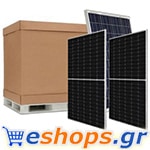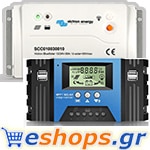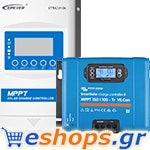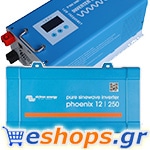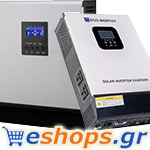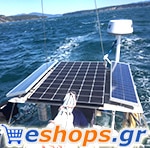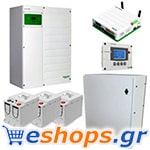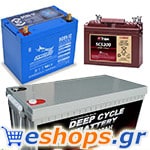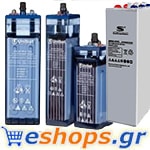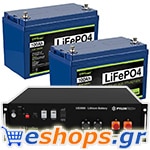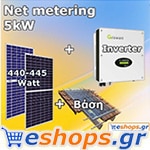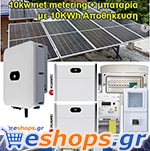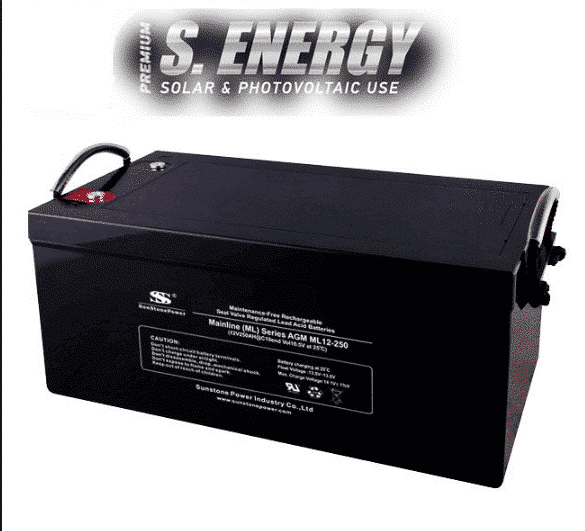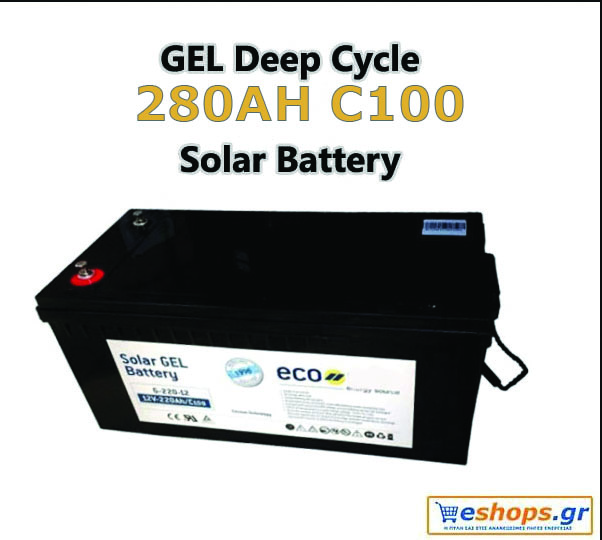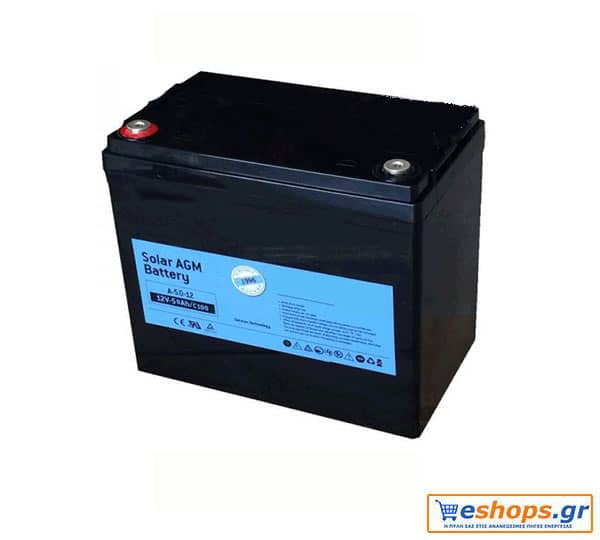Information on photovoltaic batteries
What is a photovoltaic battery and what is its use
A photovoltaic battery is an electrical storage device. The photovoltaic batteries they do not generate electricity, they store it, just as a water tank stores water for future use. As the chemicals in the battery change, electricity is stored or released. On rechargeable batteries, this process can be repeated many times. Batteries are not 100% efficient - some energy is lost as heat and chemical reactions during charging and discharging. If you use 1000 watts from a battery, it may take 1050 or 1250 watts to fully charge it.
Internal battery resistance
Most - or most - of the loss in charging and discharging batteries for photovoltaic systems due to internal resistance. This is converted to heat, which is why batteries heat up when charged. The lower the internal resistance, the better. There is a good explanation and demonstration of internal resistance here.
Slower charging and discharging rates are more efficient. A battery with a rated power of 180 amp-hours in 6 hours can have a rated value of 220 AH at a rate of 20 hours and 260 AH at the value of 48 hours. Much of this loss of efficiency is due to higher internal resistance at higher current speeds - the internal resistance is not constant - such as "the more you push, the more it pushes back".
The typical efficiency in a lead-acid battery is 85-95%, in an alkaline and NiCad battery it is about 65%. The actual degree in AGM photovoltaic batteries can reach 98% under optimal conditions, but these conditions are rarely found, so you should consider a general rule of thumb for a total power loss of 10% to 20% when sorting batteries and battery packs.
Virtually all deep discharge batteries used in photovoltaic systems and all except the smaller backup systems are Lead-Acid batteries. Even after more than a century of use, they still offer the best price-to-energy ratio. Some systems use NiCad, but we do not recommend it, except when extremely low temperatures (-50 F or less) are very common. They are expensive to buy and very expensive to discard due to the dangerous nature of cadmium.
We have had almost no direct experience with NiFe (alkaline) batteries, but from what we have learned from others we do not recommend them. An important drawback is that there is a large voltage difference between the fully charged and the discharged state. Another problem is that they are very inadequate - you lose anywhere from 30 to 40% in heat just by charging and unloading them. Many inverters and charge regulators have a very difficult time with them. F. In the past it was often used by railways as a backup force, but almost all of them have now been converted to newer types.
An important fact is that ALL batteries for photovoltaics commonly used in deep cycle applications is lead-acid. This includes standard flooded batteries, gelled and sealed AGM. They all use the same chemistry, although the actual construction of the plates etc varies.
NiCad, Nickel-Iron and other types are found in some systems, but are not common due to their cost, environmental hazards and / or poor performance.
Photovoltaic batteries - Types of batteries
The photovoltaic batteries separated by two types, from the application (what they are used for) and the construction (how they are made). The main applications are automotive, shipping and deep cycle. The deep cycle includes solar (PV) batteries, backup power, traction and RV and boat "house". The main types of construction are flooded (liquid), gelatinized and sealed AGM (absorbed Mat glass).
The AGM / VRLA deep discharge photovoltaic batteries sometimes referred to as "fallen electrolytes" or "dry", because the fiberglass layer is only 95% saturated with sulfuric acid and there is no excess liquid.
Floods can be standard, with removable covers or so-called "maintenance-free" (meaning they are designed to die a week after the warranty expires). All AGM and Gel batteries are closed and sealed with and are "valve adjustable", which means that a tiny valve maintains a slightly positive pressure. Almost all sealed batteries are "valve regulated" (commonly referred to as "VRLA" - valve regulated lead). Most regulated valves are under some pressure - 1 to 4 psi at sea level.
Battery life
Lifespan a deep charge battery for photovoltaics will vary considerably depending on how it is used, how it is stored and charged, the temperature and other factors. It can range in extreme cases - we saw that the L-16 was killed in less than a year due to severe overload and water loss and we have a large set of redundant phone batteries that only occasionally see (10-15 times a year) replaced after 35+ years. We have seen gel batteries be destroyed in a day when overloaded with a large car charger. We have seen photovoltaic batteries damaged without ever being used in less than a year because they were left uncharged. Even so-called "dry charges" (where you add acid when you need them) have a shelf life of at least 18 months.
These are some typical (minimum-maximum) expectations for photovoltaic batteries if used in deep cycle service. There are so many variables, such as rejection depth, maintenance, temperature, how often and how deep they circulate, etc., that it is almost impossible to give a fixed number.
Special purpose photovoltaic batteries "float service" often appear in the surplus market as a "deep cycle". They can vary considerably depending on age, use, care and type.NiFe (alkaline): 5-35 yearsNiCad: 1-20 yearsBoot, Marine or Deep Battery Circuit
Starters (sometimes called SLIs, for starting, lighting, ignition) are commonly used to start and run engines. Motor starters need a very large starting current for a very short time. Starter batteries have a large number of thin plates for maximum surface area. The plates consist of a lead "sponge", similar in appearance to a very thin foam sponge. This gives a very large surface area, but if it is a deep circle, this sponge will be consumed quickly and will fall to the bottom of the cells. Car batteries generally fail after 30-150 deep cycles in deep circulation, while they can last thousands of cycles in normal boot use (2-5% discharge).
Multi-cycle deep discharge batteries. The photovoltaic batteries are designed to discharge up to 80% over time and have much thicker plates. The big difference between a real deep circulation battery and others is that the plates are SOLID lead plates - not a sponge. This gives a smaller surface area, therefore less "instantaneous" power as the starter batteries need. Although these can be reduced to 20%, the best cost-effective way of life is to keep the average cycle at around 50% off. Unfortunately, this perspective often causes us to become overwhelmed when it's time to start a project. The golf cart battery is quite popular for small systems and RV's. The problem is that the "golf cart" refers to size (usually called GC-2 or T-105) and not the type of construction - so the quality and construction of a golf cart battery can vary considerably - ranging from cheap brand with thin plates up to the real deep circle like Crown, Deka, Trojan, etc. In general, you get what you pay for.
The Marine type photovoltaic batteries are usually hybrid in operation and fall between boot and deep circulation batteries, they are deep discharge batteries. In the hybrid, the plates may consist of a lead sponge, but they are thicker and heavier than those used to start the batteries. It is often difficult to say what you get in a "marine" battery, but most are a hybrid. Starter batteries are usually rated "CCA" or cold turbocharged or "MCA", marine boosters - the same as "CA". Any battery with the capacity shown in CA or MCA may or may not be a true deep-circulation battery. It is sometimes difficult to say, as the term deep cycle is often overused - we have even seen the term "deep cycle" used in the automotive industry to start the battery. The CA and MCA scores are 32 points F, while the CCA is zero. Unfortunately, the only positive way to say with some batteries is to buy one and cut it open - not much of an option.
Deep discharge battery for photovoltaics Multiple cycle as the original battery
In general, there is no problem with this, as long as it is adjusted for lower crank amplifiers compared to a similar boot battery. As a general rule, if you are going to use a real deep-release battery (such as the Concorde SunXtender) and as a starter battery, it should be about 20% larger than the existing or recommended size of the starter battery pack to have the same crank amplifiers. . This is about the same as replacing a group 24 with a group 31. With modern engines with fuel injection and electronic ignition, it generally requires much less power from the battery to turbine and start, so the first crankshaft amplifiers are less important. from,. On the other hand, many cars, boats and RV's are more loaded with energy-intensive electrical appliances, such as megawatt stereos, etc. which are more suitable for deep circulation batteries. We used Concorde SunXtender AGM batteries in some of our vehicles without any problems.
It will not hurt a deep-release battery to be used as a starter battery, but for the same battery they can not power as many crank amplifiers as a regular starter battery and it is usually much more expensive.
Επιστροφή στην κορυφή
From which batteries are there
Almost all large rechargeable batteries in common use are of the lead-acid type. (There are some NiCads that are used, but for most purposes the very high initial cost and high disposal cost do not justify them). Some types of lithium ions are starting to appear, but they are much more expensive than Lead-Acid and most load controllers do not have the right setup values for proper charging.
The acid is typically 30% sulfuric acid and 70% full load water. NiFe (Nickel-Iron) batteries are also available - they have a very long life, but rather low efficiency (60-70%) and voltages are different, making it more difficult to pair with standard 12v / 24 / 48v systems and converters. . The biggest problem with NiFe batteries is that you may need to charge 100 watts to get a 70 watt charge - they are much less effective than Lead-Acid. What you save on batteries you have to replenish by buying a larger solar panel system. NiCads are also inadequate - usually around 65% - and very expensive. However, NiCads can be frozen without damage, so they are sometimes used in areas where temperatures can drop below -50 degrees F. Most AGM batteries will also survive freezing without problems.
Deep circulation industrial batteries
Sometimes referred to as "lifting forklifts", "traction" or "stationary" batteries, they are used when electricity is required for a longer period of time and are designed for "deep circulation" or are unloaded up to 20% (80% DOD or rejection depth). These are often called traction arrays because of their widespread use in forklifts, golf carts and floor brooms (from which we get the "GC" and "FS" battery packs). Deep cycle batteries have much thicker plates than car batteries. They are sometimes used in larger photovoltaic installations because you can enjoy a lot of storage on a single (very large and heavy) battery.
Slab Thickness
The thickness of the plate (positive plate) is important due to a factor called "positive grid corrosion". This ranks among the top 3 reasons for battery failure. The positive (+) sign is what gets eaten up gradually over time, so in the end there is nothing left - everything falls to the bottom as sediment. Thicker plates are directly related to longer life, so that other things being equal, the battery with thicker plates will last as long as possible. The negative plate on the batteries expands slightly during discharge, which is why almost all batteries have separators, such as glass or paper, that can be compressed.
Car batteries typically have plates about .040 "(4/100") thick, while forklift batteries can have plates larger than 1/4 "(.265" for example in a larger Rolls-Surrette) - almost 7 times thicker. batteries. The Rolls-Surrette L-16 (CH460) is .150 ", while the US Battery and Trojan L-16 (CH460) 16 are .090". The size Crown L-16HC has plates 22 inches thick. While plate thickness is not the only factor in the number of deep cycles a battery can take before it dies, it is the most important.
Most industrial deep-lift batteries use lead-antimony plates instead of the lead-calcium used in AGM or gelled deep-circuit batteries and car starter batteries. Antimony increases the duration and strength of the plaque, but increases gas and water loss. This is why most industrial batteries need to be checked frequently for water level if you do not have Hydrocaps. Self-discharge of batteries with lead-antimony plates can be high - up to 1% per day on an older battery. A new AGM usually discharges at about 1-2% per month, while an old one can be as much as 2% per week.
Closed type Deep discharge batteries for photovoltaics
Closed type batteries are made with fans which (usually) can not be removed. So-called maintenance-free batteries are also sealed, but are not usually waterproof. Sealed batteries are not completely sealed, as they must allow gas to evaporate during charging. If overcharged too many times, some of these batteries may lose enough water that they will die prematurely. Most smaller deep-release batteries (including AGMs) use lead-calcium plates for longer life, while most industrial batteries and forklift batteries use lead-antimony plates for greater plate resistance to shock and vibration.
Lead-antimony batteries (such as forklifts and floor cleaners) have a much higher rate of self-absorption (2-10% per week) than lead or calcium lead (1-5% per month), but antimony improves the mechanical strength of the plates, which is an important factor for electric vehicles. They are generally used when they are under constant or very frequent charge / discharge cycles, such as fork lifters and floor brooms. Antimony increases plaque life at the expense of higher self-discharge. If left unused for long periods of time, they should be charged to avoid sulfur damage - but this applies to ANY battery.
As with all things, there are compromises. Lead-antimony types have a very long lifespan, but higher self-discharge rates.
Battery size codes
Batteries come in all different sizes. Many have "group" sizes, which are based on the physical size and placement of terminals. It is not a measure of battery capacity. The standard BCI codes are groups U1, 24, 27 and 31. Industrial batteries are usually designated with an accessory number such as "FS" for the floor broom or "GC" for the golf cart basket. Many batteries do not follow a specific code and are just manufacturer numbers. Other key size codes are 4D & 8D, large industrial batteries commonly used in solar power systems.
Some common battery size codes used are: (estimates are approximate)
U134 to 40 Amp hours 12 volts Group 2470-85 hours hours 12 volts Group 2785-105 hours Amp12 volts Group 3195-125 hours Amp12 volts 4-D180-215 hours Amp12 volts 8-D225-255 hours Amp12 volts Golf Cart & T-105180 to 225 AmL hours 6 b , L16HC etc.16 to 340 hours 415 volts
Electrolyte with gel
Recharged batteries or "gel cells" contain acid which has "coagulated" with the addition of silica gel, turning the acid into a solid mass resembling gooey Jell-O. The advantage of these batteries is that it is impossible to spill acid even if they are broken. However, there are many disadvantages. One is that they must be loaded at a slower rate (C / 20) to avoid excessive destruction of the cells by the gas. They cannot be charged quickly to a conventional car charger or may be permanently damaged. This is not usually a problem with solar power systems, but if an auxiliary generator or a bulk inverter charger is used, the current should be limited by the manufacturer's specifications. The best converters commonly used in solar power systems can be adjusted to limit the charging current in the batteries.
Some other disadvantages of gel cells are that they have to be charged at a lower voltage (2 / 10th less) than flooded or AGM batteries. If overloaded, gaps can develop in the gel, which will never heal, causing a loss of battery capacity. In hot climates, water loss can be enough for 2-4 years to cause premature death of the battery. For this reason and for other reasons, we no longer sell any of the gelatin cells except for replacement use. Newer AGM (absorbent glass) batteries have all the advantages (and then some) gelled, without any of the disadvantages.
AGM (Absorbed Glass) Batteries
Check out the most popular AGM brands: Universal Power Group, Concorde SunXtender and Fullriver Battery.
A newer type of sealed battery uses "absorbed glass mats", or AGM between the plates. This is a very thin boron-silicate glass mat. These types of batteries have all the advantages of gelled, but can get a lot more abuse. We sell AGM Concorde batteries (and Lifeline, made by Concorde). These are also called "fatty electrolytes", as the layer is about 95% saturated and not fully impregnated. This also means that acid will not leak even if it breaks.
AGM batteries have many advantages over gelled and flooded, at about the same cost as gelled:
Since all the electrolyte (acid) is contained in the glass, it can not be spilled, even if it breaks. This also means that since they are not dangerous, shipping costs are lower. In addition, since there is no liquid to freeze and expand, it is practically immune from freezing damage.
Almost all AGM batteries are "recombinant" - this means that Oxygen and Hydrogen are recombined inside the battery. They use the transfer of oxygen phase gas to the negative plates to recombine in water while being charged and prevent water loss through electrolysis. Recombination is usually 99 +% efficient, so there is almost no water loss.
The charging voltages are the same as for any standard battery - no special settings or problems with incompatible chargers or chargers are required. And, as the internal resistance is extremely low, there is almost no heating of the battery even under strong charging and discharging currents. Concorde batteries (and most AGMs) have no charge or discharge currents.
AGMs have very low self-discharge - from 1% to 3% per month is common. This means that they can sit in storage for much longer periods without being charged than regular batteries. Concorde batteries can be recharged almost completely (95% or better) even after 30 days of full charge.
AGMs have no liquid to spill and even under severe overload conditions the hydrogen emission is much lower than the maximum of 4% set for aircraft and indoors. The plates in the AGM units are full and tightly fitted and will withstand shocks and vibrations better than any standard battery.
Even with all the advantages listed above, there is still a place for the standard flooded deep circulation battery. AGM will cost about 1,5 to 2 times more than flooded batteries of the same capacity. In many installations where the batteries are located in an area where you do not have to worry about smoke or leaks, a standard or industrial deep cycle is a better economical choice. AGM batteries main advantages are no maintenance at all, fully sealed against smoke, hydrogen or leakage, non-leakage even if broken and can survive most frosts. Not everyone needs these features.
Επιστροφή στην κορυφή
Temperature effects on batteries
The capacity of the battery (how many amp-hours it can last) decreases as the temperature decreases and increases as the temperature increases. This is why your car battery dies on a cold winter morning, even though it was good the previous afternoon. If your batteries spend part of the time flickering in the cold, the reduced capacity should be taken into account by the size of the system batteries. The standard rating for batteries is at room temperature - 25 degrees C (approximately 77 F). At about -22 degrees F (-27 C), the AH capacity of the battery drops to 50%. During freezing, the capacity is reduced by 20%. Capacity increases at higher temperatures - at 122 degrees F, the battery capacity will be about 12% higher.
Battery charging voltage also changes with temperature. It will range from about 2,74 volts per cell (-16,4 V) at -40 C to 2,3 V per cell (13,8 V) at 50 C. For this reason you should have a temperature compensation in the charger. or charge control if your batteries are out and / or subject to large temperature fluctuations. Some charging controls have built-in temperature compensation (like Morningstar) - this works well if the controller is subject to the same temperatures as the batteries. However, if your batteries are out, and the controller is in, it will not work as well. Adding another complication is that large battery banks form a large thermal mass.
Thermal mass means that because they have so much mass, they will change the internal temperature much more slowly than the ambient temperature. A large insulated battery bank can vary as little as 10 degrees for 24 hours indoors, even though the air temperature ranges from 20 to 70 degrees. For this reason, the external temperature sensors should be connected to one of the POSITIVE plate terminals and be slightly stacked with some kind of insulation in the terminal. The sensor will then read very close to the actual internal temperature of the battery.
Although the capacity of the battery at high temperatures is higher, the battery life is reduced. Battery capacity decreases by 50% to -22 degrees F - but the LIFE battery increases by about 60%. Battery life is reduced at higher temperatures - for every 15 degrees F over 77, the battery life is reduced by half. This applies to ANY type of Lead-Acid battery, whether sealed, gelled, AGM, industrial or anything else. This is not really as bad as it seems, as the battery will tend to count the good and bad times on average. Click on the small graph to see a full size temperature versus capacity chart.
One last note about temperatures - in some areas with extremely cold or hot conditions, batteries may be sold locally, which are NOT typical electrolyte (acid) resistances. The electrolyte may be stronger (for cold) or weaker (for very hot) climates. In such cases, the specific gravity and trends may differ from what we show.
Circles vs Life
The "cycle" of the battery is a complete cycle of discharging and recharging. It is usually considered to be discarded from 100% to 20%, and then back to 100%. However, there are often ratings of other levels of discharge cycles, the most common being 10%, 20% and 50%. You need to be careful when looking at the ratings that list the number of cycles for which a battery has been rated, unless it also indicates how far it is discharged. For example, one of the most widely used telephone batteries (float service) has been advertised to have a lifespan of 20 years. If you look at fine print, it only has this rating at 5% DOD - it's a lot less when used in an application where they go deeper on a regular basis. These same batteries are rated in less than 5 years if they are running at 50%. For example,
Battery life is directly related to how deep the battery is each time. If a battery is discharged at 50% every day, it will last about twice as long as if it were released at 80% DOD. If only 10% DOD is released, it will take about 5 times as long as one is released at 50%. Obviously, there are some practical limitations to this - you usually do not want to have a pile of 5 tonnes of batteries sitting right there to lower the DOD. The most practical number you should use is 50% DOD on a regular basis. This does NOT mean that you can not go up to 80% at once. It's just that when designing a system when you have an idea for loads, you should calculate an average DOD of about 50% for the best storage factor for the cost. There is also a limit - a battery that is constantly running at 5% or less will usually not last as long as a cycle is reduced by 10%. This is because in very shallow cycles, lead dioxide tends to accumulate in clusters on the positive plates rather than in a uniform film. The graph above shows how lifespan is affected by the depth of rejection. The map is for a Concorde Lifeline battery, but all lead-acid batteries will be similar in shape to the curve, although the number of cycles will vary.
Επιστροφή στην κορυφή
Battery voltages
All Lead-Acid batteries provide approximately 2,14 volts per cell (12,6 to 12,8 for a 12 volt battery) when fully charged. Batteries stored for long periods of time will eventually lose all their charge. This "leak" or self-discharge varies considerably depending on the type of battery, age and temperature. It can range from about 1% to 15% per month. In general, new AGM batteries have the lowest and old industrial (lead-antimony plates) have the highest. This is a rare problem in systems that are constantly connected to a type of charging source, whether it is solar, wind or AC charger. However, one of the biggest killers of batteries sits stored in a partially discharged state for a few months. A "float" charge battery must be retained in the batteries even if not in use (or, if not in use). Even most "dry" batteries (those sold without electrolyte so they can be transported more easily, with acid added later) will deteriorate over time. The maximum storage time in them is about 18 to 30 months.
Batteries self-discharge faster at higher temperatures. Shelf life can also be significantly reduced at higher temperatures - most manufacturers state this as a 50% loss for every 15 degrees F at 77 degrees Celsius. Life expectancy increases at the same rate if it is below 77 degrees, but capacity decreases. This tends to normalize in most systems - they will spend part of their lives at higher temperatures, and part at lower temperatures. Typical self-supply rates for floods are 5% to 15% per month.
Myth: The old myth about not storing batteries in concrete floors is just that - a myth. This story has been around for 100 years and started when battery cases are made of wood and asphalt. The acid will leak from them, forming a slow discharge circuit through the now acidic impregnated and conductive floor.
Billing status
Charging status or vice versa discharge depth (DOD) can be determined by measuring the voltage and / or specific gravity of the acid with a hydrometer. This will not tell you how good (capacity in AH) the condition of the battery is - only a prolonged charge test can do that. The voltage on a fully charged battery will read 2,12 to 2,15 volts per cell or 12,7 volts on a 12 volt battery. At 50% the reading will be 2.03 VPC (Volts Per Cell), and at 0% it will be 1.75 VPC or less. The specific gravity will be about 1,265 for a fully charged cell and 1,13 or less for a fully discharged cell. This can vary somewhat depending on the type of battery and the brand - when you buy new batteries you will need to charge them and let them sit for a while, then take a reference measurement. Many batteries are sealed and the water meter cannot be measured, so you have to rely on voltage. Hydrometer measurements may not tell the whole story, as it takes a while for the acid to mix with liquid cells. If measured immediately after charging, you may see 1,27 at the top of the cells, although it is much lower at the bottom.
"Wrong" Capacity
A battery can withstand voltage tests to be fully charged, but much lower than its original capacity. If the plates are damaged, sulfurized or partially obsolete, the battery may give the appearance of a full charge, but it actually acts as a much smaller battery. The same thing can happen to gelatin cells if they are overloaded and there are gaps or bubbles in the gel. What's left of the plates may be fully functional, but with only 20% of the dishes left… Batteries usually go bad for other reasons before they get to this point, but it's something you need to know if your batteries seem to be trying OK but lack capacity and fall dead very quickly under load.
In the table below, you must be careful not to measure only the surface charge. To properly control the voltage, the battery should sit still for a few hours or you should place a small load on it, such as a small car lamp, for a few minutes. The following voltages apply to all lead-acid batteries except gelled. For gel cells, subtract the 2 volts. Note that the actual charging voltages will be quite different, so do not use these numbers for a battery that is being charged.
Amp-Hours - What is it?
All deep scroll batteries are rated in hours per minute. An amp-hour is an amplifier for one hour or 10 amp for 1/10 of an hour and so on. They are amplifiers x hours. If you have something that pulls 20 amps and you use it for 20 minutes, then the operating hours used will be 20 (amps) x .333 (hours) or 6,67 AH. The generally accepted AH rating period for batteries used in solar power and backup power systems (and for almost all deep cycle batteries) is "20 hours". (Some, like Concorde AGM, use the 24-hour interest rate, which is probably a better rating in the real world). This means that it is discharged at 10,5 volts over a period of 20 hours while the total actual useful time is measured. Sometimes they are rated at 6 hours and 100 hours are also provided for comparison and for different applications. The 6-hour rate is often used for industrial batteries, as it is a typical daily operating cycle. Sometimes the value of 100 hours is only given to make the battery look better than it really is, but it is also useful to calculate the capacity of the battery for long-term backup requirements per hour.
Why hourly hours are set at a certain rate:
Because of something called the Peukert Effect. The Peukert value is directly related to the internal resistance of the battery. The higher the internal resistance, the greater the losses during charging and discharging, especially at higher currents. This means that the faster a battery is used (discharged), the lower the AH capacity. Conversely, if depleted more slowly, the AH capacity is higher. This is important because some manufacturers and retailers have chosen to rate their batteries for the price of 100 hours - which makes them look much better than they really are. Here are some typical battery capacities from the manufacturer's data sheets:
Battery type100 hoursPercent of 20 hours8Trojan T-105250 AH225 AHn / aUS Battery 2200n / a225 AH181 AHConcorde PVX-6220255 AH221 AH183 AHSurrette δ-460 (L-16) 429 AH344 AHH282 16400HH ALC Billing status
Here are typical trends without load in relation to the charging status
(shown at 10,5 volts = fully discharged and 77 degrees F). The voltages are for a 12 volt battery system. For 24 V systems multiply by 2, for a 48 V system multiply by 4. VPCs are volts per individual cell - if you measure a difference of more than .2 volts between each cell, you must equalize or your batteries must be bad, or may be sulfated. These voltages are for batteries that have been quiet for 3 hours or more. The batteries that are being charged will be higher - the voltages while they are being charged will not tell you anything, you have to let the battery sit for a while. For longer life, the batteries should remain in the green zone. Occasional yellow dips are not harmful, but continuous discharges to these levels will significantly reduce battery life. It is important to realize that voltage measurements are only approximate. The best determination is to measure the specific gravity, but on many batteries this is difficult or impossible. Note the large voltage drop in the last 10%.
Charging status 12 volts batteryVolts per Cell100% 12.72.1290% 12.52.0880% 12.422.0770% 12.322.0560% 12.202.0350% 12.062.0140% 11.91.9830% 11.751.9620% 11.581.9310% 11.311.89010.51.75Return to the top
Why 10,5 Volts?
Throughout this FAQ, we have stated that a battery is considered dead at 10,5 volts. The answer has to do with the internal chemistry of batteries - at about 10,5 volts, the specific gravity of the acid in the battery becomes so low that there is very little left to do. In a dead battery, the specific gravity can drop below 1,1. Some real tests were recently done on a battery from one of our solar forum posters and here are the results:
I just tried a 225 degree cycle battery that is in good working order ..
I put a load on this 30a for 4 hours that dropped its voltage to 11,2 Let
then cool for 2 hours,
then put the load back again at 1 hour 42 minutes dropped to 10.3v
35 minutes under 30a load 9.1v (273w)
10 minutes later maximum output current 11.6a 8.5v (98.6w)
5 minutes later maximum output current 5.2 amps 7.9v (41w)
3 minutes later 7.6v and 2.3a (17.5w)
This shows that once it reaches below 10.3 v you only have 35 minutes of anything useful available from the battery.
the battery is dead now and will probably not fully recover Battery charge
The battery is charged in 3 basic stages: Mass, Absorption and Floating.
Bulk charging - The first stage of charging the battery in 3 stages. The current is sent to the batteries at the maximum safe speed it will receive until the voltage increases to almost (80-90%) level of full charge. The voltages at this stage typically range from 10,5 volts to 15 volts. There is no "correct" voltage for bulk charging, but there may be limits to the maximum current that the battery and / or wiring can receive.
Absorption charge: The 2nd stage of charging the battery in 3 stages. The voltage remains constant and the current gradually decreases as the internal resistance increases during charging. During this stage the charger exits the maximum voltage. The voltages at this stage are usually around 14,2 to 15,5 volts. (The internal resistance increases gradually because there is less and less to be converted to normal full charge).
Float charge: The third stage of charging the battery in 3 stages. Once the batteries are fully charged, the charging voltage is reduced to a lower level (typically 12,8 to 13,2) to reduce gas production and extend battery life. This is often referred to as maintenance or ash charging, as its main purpose is to maintain an already charged battery. PWM or "pulse amplitude modulation" does the same thing. In PWM, the controller or charger detects small voltage drops in the battery and sends very short charge cycles (pulses) to the battery. This can happen several hundred times per minute. It is called "pulse width" because the pulse width can range from a few microseconds to several seconds. Note that for long-term float service, such as spare power systems that are rarely discharged, the float voltage should be between 13,02 and 13,20 volts.
Explosives: Most garage and consumer (car) battery chargers are only bulk and have low (if any) voltage regulation. It's nice for a quick push on low batteries, but they do not stay on for long periods of time. Adjustable chargers include voltage regulators such as Iota Engineering, PowerMax and others, which maintain a constant voltage in the batteries. If they are set to the correct voltages for your batteries, they will keep the batteries charged without damage. These are sometimes called "cone charges" - as if they were a point of sale. What charging really means is that as the battery charges, the voltage goes up, so the amplifiers drop from the charger. They charge well, but a charger rated at 20 amps can only provide 5 amps when the batteries are 80% charged. To achieve this, Xantrex (and maybe others?) Have come up with "smart" or multi-stage chargers. They use a variable voltage to keep the charge amplifiers much more stable for faster charging.
We have all Iota Engineering battery chargers.
Επιστροφή στην κορυφή
Charging controllers
A load controller is a regulator that goes between solar panels and batteries. The regulators for solar systems are designed to keep the batteries fully charged without overcharging. Amplifier meters (from the panels) and Volts batteries are optional with most types. Some of the various brands and models that we use and recommend are listed below. Note that some of them are referred to as "power trackers" - for a full explanation, see our page "Why 130 Watt is not equal to 130 Watt".
Most of the modern controllers have a built-in automatic or manual equation and many have a LOAD output. There is no "best" controller for all applications - some systems may need the more expensive control bells and whistles, others may not.
These are some of the charging controllers we recommend, but almost any modern controller will work well. The exact model will depend on the application and the size of the system, the intensity and the voltage.
Xantrex
Morningstar
Midnite Solar
Outback Power
Steca
You can find all of these brands, as well as others, in the Charge Controller section.
Using any of these will almost always deliver better battery life and charging compared to "off" or simple branch type regulators
Επιστροφή στην κορυφή
Battery charging voltages and currents:
Most flooded batteries should be charged at a maximum of "C / 8" for any extended period. While some battery manufacturers claim a higher maximum charge rate, such as C / 3, higher charge values may result in high battery temperatures and / or excessive drainage and fluid loss. ("C / 8" is the 20-hour battery capacity divided by 8. For a 220 AH battery, this would be equivalent to 26 Amps.) The gelled cells must be charged to a rate of no more than C / 20 or 5 % of their amp-hour capacity. Concorde and some other AGM batteries are a special case - they can be charged at Cx4 or 400% of the capacity for the bulk cycle for a short time. However, since very few battery cables can take up so much power, we do not recommend trying this at home. To prevent the cable from overheating, you should stick to C / 4 or less.
Charging at 15,5 volts will give you 100% charge on Lead-Acid batteries. Once the charging voltage reaches 2.583 volts per cell, charging should be stopped or reduced to a slow flow load. Note that flooded batteries MUST cause some bubbles (gas) to ensure full charge and to mix the electrolyte. The buoyancy voltage for Lead-Acid batteries should be about 2,15 to 2,23 volts per cell or about 12,9-13,4 volts for a 12 volt battery. At higher temperatures (above 85 degrees F), this should drop to about 2,10 volts per cell.
Never add acid to a battery other than replacing spilled liquid. You must use distilled or deionized water to remove unsealed batteries. Upgrades and charging voltages for gel batteries are usually about 2 / 10th volts less than for floods to reduce water loss. Keep in mind that many load controllers sold for solar systems will not give you a full charge - check the specifications first. To be fully charged, you must continue to apply a current after the battery voltage has reached the cut-off point of most of these types of controllers. This is why we recommend the charging controls and battery chargers listed in the sections above. Not all branching controllers are enabled or disabled, but most are.
Flooded battery life can be extended if there is charge balance applied every 10 to 40 days. This is a charge that is about 10% higher than the normal full charge voltage and lasts for about 2 to 16 hours. This ensures that all the cells are equally charged and the gas bubbles mix the electrolyte. If the liquid in standard fluid cells is not mixed, the electrolyte becomes "layered". You can have a very strong solution at the bottom and a very weak one at the top of the hive. With stratification, you can test a battery with a hydrometer and take measurements that are quite far away. If for some reason you can not equalize, you should allow the battery to sit for at least 24 hours and then use the hydrometer. AGM and gelled should be balanced 2-4 times a year at most - check the manufacturers recommendations, especially in gelled.
Battery aging
As batteries grow, so do their maintenance requirements. This means longer charging time and / or higher finishing rate (higher intensity at the end of charging). Older batteries usually need to be watered more often. And, their capacity decreases while the rate of self-absorption increases.
Mini Facts
Almost all batteries will not reach full capacity until they are circulating 10-30 times. A brand new battery will have a capacity of about 5-10% less than the rated capacity.
The batteries should be watered after charging, unless the plates are exposed, and then add enough water to cover the plates. After full charge, the water level should be even in all cells and usually 1/4 "to 1/2" below the bottom of the magazine in the cell (depending on the size and type of battery) .
In cases where multiple batteries are connected in series, parallel or serial / parallel, replacement batteries must be the same size, type and manufacturer (if possible). The age and level of use must be the same as the batteries. Do not insert a new battery in a package longer than 6 months or with more than 75 cycles. Replace with any new ones or use a good battery. For long-life batteries such as the Surrette and Crown, you can have a one-year age difference.
The vent caps on flooded batteries must remain in the battery during charging. This greatly prevents water loss and splashing that can occur when gushing.
When you first purchase a new set of flood (liquid) batteries, you will need to charge and fully charge them, and then take a hydrometer reading for future reference. Since not all batteries have the same acidity, this will give you a baseline for future readings.
When using a small solar panel to maintain charge (maintenance) on a battery (without the use of a charge controller), select a panel that will give a maximum output of approximately 1/300 to 1/1000 of the amp-hour capacity. For a pair of golf cart batteries, this would be about 1 to 5 watt panels - the smaller panel if you have 5 or more hours of sunshine a day, the larger for long cloudy winter days in the northeast.
Lead-Acid batteries do NOT have memory and the rumor that they must be fully discharged to avoid this "memory" is completely incorrect and will lead to premature battery failure.
Inactivity can be extremely damaging to a battery. It's a very poor idea to buy new batteries and save them later. Either you buy them when you need them or you keep them in constant charge. The best thing - if you buy them, use them.
Only clean water should be used to clean the outside of the batteries. Solvents or spray cleaners should not be used.
Some Peukert exhibitor prices (incomplete, for information only). We do not have much data. Trojan T-105 = 1,25. Optima 750S = 1.109. US battery 2200 = 1,20.
Επιστροφή στην κορυφή
More information - Manufacturers' websites
US Battery Manufacturing Company - some good information and data.
Crown Battery - A major manufacturer of industrial and deep cycle batteries.
Trojan Battery - Not a lot of real technical information here, but it has all the specs.
Exide - not much here, but marketing, but you can buy Exide T-shirts. We do not sell Exide.
Surrette - Characteristics and data about the Surrette cycle and marine batteries
Concorde - specifications and data for all Concorde batteries, including the Lifeline line.
Please do not hesitate to email us with comments about this page or batteries in general.



